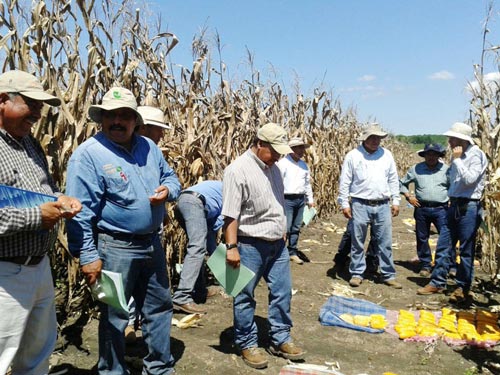
By Alberto Chassaigne/CIMMYT
Participants in the Sustainable Modernization of Traditional Agriculture (MasAgro) initiative witnessed the introduction of six new maize hybrids aimed at increasing productivity in rainfed areas of Mexico’s lowland tropics. Along with representatives of 16 Mexican seed companies and a national public sector research institution, the guests attended a demonstration at CIMMYT’s Agua Fría experiment station in the state of Puebla on 10 October.
The event also included a talk on the agronomic practices and pest and disease control measures commonly used in that region. Alberto Chassaigne, CIMMYT maize seed systems specialist, reported on the progress of entering the maize hybrids and varieties evaluated through MasAgro’s Collaborative Testing Network for the Tropics into the National Catalog of Plant Varieties of Mexico’s National Seed Inspection and Certification Service. Information on the characterization of these materials will be available to network seed producers for the effective selection of seed lots to produce certified seed, he added.
Ubaldo Marcos, CIMMYT’s seed production manager, and Manuel Velázquez, seed technology and production consultant, gave a talk on seed production technology. The participants also observed grain harvested from the six new hybrids, as well as their parents, to determine their potential for producing certified seed. In closing, Félix San Vicente, leader of MasAgro-Maize, invited seed producers to identify the best tropical hybrids being tested through the network by examining the plants in the test plots and the harvested grain. This exercise confirmed the competitiveness of white and yellow grain hybrids, which performed better than the commercial controls. Participants will continue to attend other training and dissemination events.
 Capacity development
Capacity development 
